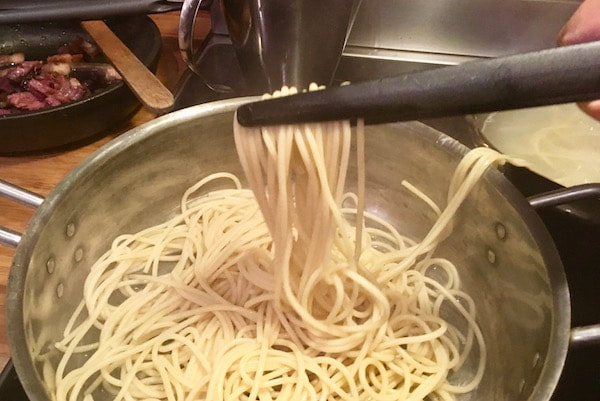|
Glamorous night of restaurant awards - 900 guests, mood lighting, mirror balls, black table cloths, glinting glassware, ice-buckets heaving with beer, butter in pretty shapes, spilt wine, extremely high heels and delicious décolletés. Our food was uniformly excellent (900 guests!) with all pregnancies, allergies, glutards and possible phobias carefully attended to. It all worked. How do they do it? That said, they must employ a bard of Shakespearian virtuosity to write the menu. Our main course was a treasury, a plethora, a cornucopia, an abundance, a superfluity, a profusion, a torrent, a deluge, a surfeit of words, words, words. "Herb-crusted lamb rack with pulled shoulder, skordalia, caramelised beetroot compôte, garlic-fried beans, pumpkin crisps and pinot jus." (What about salt and pepper? Which herbs? It could have been even longer!) Why do they do this? All joking aside, I must say the dish was delicious and to use a cliché, cooked to perfection. The hero, a small rack of lamb, was tender, and nicely pink inside, the pulled shoulder an interesting contrast of texture. The skordalia, (posh mashed potato with a hint of garlic) was a perfect foil for the beetroot in both flavour, texture and colour. The beans ensured we got our quota of greens as well as a verdant (posh word for green) component. The crisp pumpkin shavings gave a nice crunch. The whole dish was held together by a jus (posh for gravy) of balanced acidity and abundance. It's a given surely that vegetarians will announce themselves beforehand, as will those allergic to say, seafood, gluten or peanuts. How much do you need to know?
I was at one of the legendary dinners of the Symposium on Australian Gastronomy (1993) in Canberra where the menu was a simple list of words. Eggs Flesh Bones Skin Blood Heart Milk Fruit They knew their audience. We sat with an open mind and generous spirit of adventure. It wasn't at all scary and was impeccably produced. "Bones" referred to a rich consommé accompanied by roasted marrow bones, "Milk" naturally was the cheese course, "Fruit" a course where the table was piled with grapes. I think I remember rightly that "Skin" referred to Atlantic salmon topped with crispy strips of seared salmon skin. Would it have been too terrifying a challenge for today's food phobics? Would there be a worrying loss of control, knowing so little? I recently came across the dish below at a local eatery, very different from my lamb rack or the Symposium dinner. Once again it was delicious. On the menu, it was "Compost". Now that's a challenge. Was it a hard or an easy sell for a bunch of roasted vegetables sitting on "charcoal brioche soil"?
This reminds me. We did "soil", in 2010. We got the idea from a book. The dish was called "Terroir". Imagine beetroot and chocolate soil, topped with a goats' curd sorbet, spears of baby asparagus poking through a snow of sorrel granita, assorted freeze-dried berries, and micro herbs (of course). We thought we were pushing boundaries. You have to be able to laugh at yourself. Comment or Like (👍🏼 or 👇) see the fine print below.
3 Comments
Every now and then, a myth gets exposed. Yes, wooden chopping boards are more hygienic than plastic. No, mama does not have to stand in the kitchen for three quarters of an hour stirring the risotto. Every now and then a dish based on an arcane tradition becomes a hit. Casio e pepe is the pasta of the moment. Catch it now before it slips away like last year's turmeric latte, celery juice and smashed avocado. The recipe below also plays with a new way to cook pasta. Don't tell the Italians. They might not believe you. Casio e pepe - Pasta with pepper and cream (Possibly my favourite plates - Czech Eichwald Porcelain until 1939, now Cesky Porcelain. Grateful for any more information.) Casio e pepe is cheesy and creamy without the addition of cream or oil, not that there's anything wrong with either. The method is interesting and can be used any time for other combinations. It's made from three ingredients. Three, if you don't count salt and water. Pasta - Pecorino - black pepper - that's it. The recipe is for two people. It's best made just when you want to eat it and for no more than four people at a time. Use good quality spaghetti (rather than say, lasagne) - one of the brands with a rough, white, flaky surface. The pasta is cooked in a shallow pan, not in lots of boiling water. This way, the starch from the pasta is more concentrated, and that makes the sauce. Left: pasta cooking in my shallow fish pan. Right: Tonging the pasta into the saucepan so as not to lose the cooking water. Casio e pepe (Spaghetti with Cheese and Pepper) Serves 2 as a small main course. 180 gm good quality spaghetti 90 gm finely grated Pecorino 1 tbsp whole peppercorns (more or less - should that be more or fewer?)
After I'd finished writing and "researching" this, I discovered Alex - Just a French Guy YouTube Highly recommended. This guy is HOT. Introduce him to a beginner and get some cooking happening. The French Guy Then follow with his next episode where he improves on the method and worries about the "Italian backlash". By the way, I did tell an Italian. Rosa thought my first dish was too saucy and preferred the one below. (Perhaps she prefers the plate.) Try it and tell me how you go.
Comment or Like (👍🏼 or 👇) see the fine print below. What's the mystery fruit? They're large, like a mango and smooth. They're Japanese quinces. Given these by a friend from her tree, I had to make more quince paste. Perhaps it was the ripeness, but the pectin content was intense, making a very firm paste.  This is a time consuming, heavy going and dangerous production (nothing wrong with that). The only reason I'm a dab hand at it is that it's one of the few things for which I use my Thermomix. No erupting molten paste, no risk of repetitive strain injury from hours stirring the pot. The Spanish idea to serve quince paste alongside say, Manchego, (a firm, sheep's milk cheese) is now common to most cheese platters. But for cheese accompaniments that go beyond the usual...

The rugged individualists can do as they please of course but I'd suggest pears or grapes over strawberries (no!), dried figs over glacé fruit. By the way, if you're offering a crisp "ficele" of a baguette (long, small, round, named after a pice of string), cut it on a slant rather than serve nasty little "knobs". It's certainly the very, very tail-end of the quince season but if you have a Thermomix and would like the no effort recipe/method, send me a note below.
Comment?👇 Recipe request? 👇 Or just like👍🏼 Pre-occupied with hospitality workshops, I missed two important dates, (three if you count World Chocolate Day, which hardly needs a memory jolt). Don't know how I could have missed last week's World Negroni Week. I was led to the Negroni through Luca Turin's articles and books on the subject of scent (The Secret of Scent and Perfume: The A - Z Guide.) His writing is brilliant (but perhaps I say this because I agree wholeheartedly with his ratings). He gave up his "smellings" for a while due to the demands of his real job as a biophysicist, although occasional blogging suggest that the bug is still strong. He extolled the allure of bitterness - in scents, in food and in life. A touch of bitter could be found in the perfumes of Bandit (Piguet), Knize 10 (Knize), Bois de Violette (Serge Lutens) for example. One could imagine a life of of bitter greens, dark chocolate (of course), wafts of Chanel's Cuir de Russie, a cello concerto by Shostakovich perhaps, and a Negroni, packed with ice. Playing with variants (or deviants) - Negroni week, Wilmott's, Adelaide. They say it was invented in Florence in 1919 when a certain Count Camillo Negroni asked his barman to up the ante on his usual Americano (Campari, sweet Vermouth and a large splash of soda) by replacing the soda with gin. This could be challenged by a General Pascal de Negroni in 1857 but you know how these tales escalate... The concoction (equal parts Campari, sweet Vermouth, gin) is stirred, poured over plenty of ice and a large slice (or chunk) of orange. The orange, with its peel, is essential. It's the perfect pre-prandial cocktail, with the bitterness sharpening the appetite (not that I've ever found appetite a problem). AND... It's been a year since the passing of Anthony Bourdain and not a week goes by without a reminder of his down-to-earth, sensible and sensitive ideas. "Basic cooking skills are a virtue. The ability to feed yourself and a few others with proficiency should be taught to every young man and woman as a fundamental skill. It's as vital to growing up as learning to wipe one's ass (sic), cross the street by oneself, or be trusted with money."
BUT, in the kitchen and at the key-board this week, I've been all over cacio e pepe (like a pitbull on a poodle, to quote Seinfeld's Library Cop). This is a pasta dish that is creamy and saucy without the addition of butter, cream, (and sometimes even oil), relying simply on exploiting the starch in the pasta cooking water. Brilliant. AND, how "spooky", as Dame Everage would say. Turns out this was Anthony Bourdain's favourite, all time, come what may, desert island pasta dish! Recipe to come. Comment below 👇 or simply 👍🏼 |
Categories
All
|














 RSS Feed
RSS Feed
